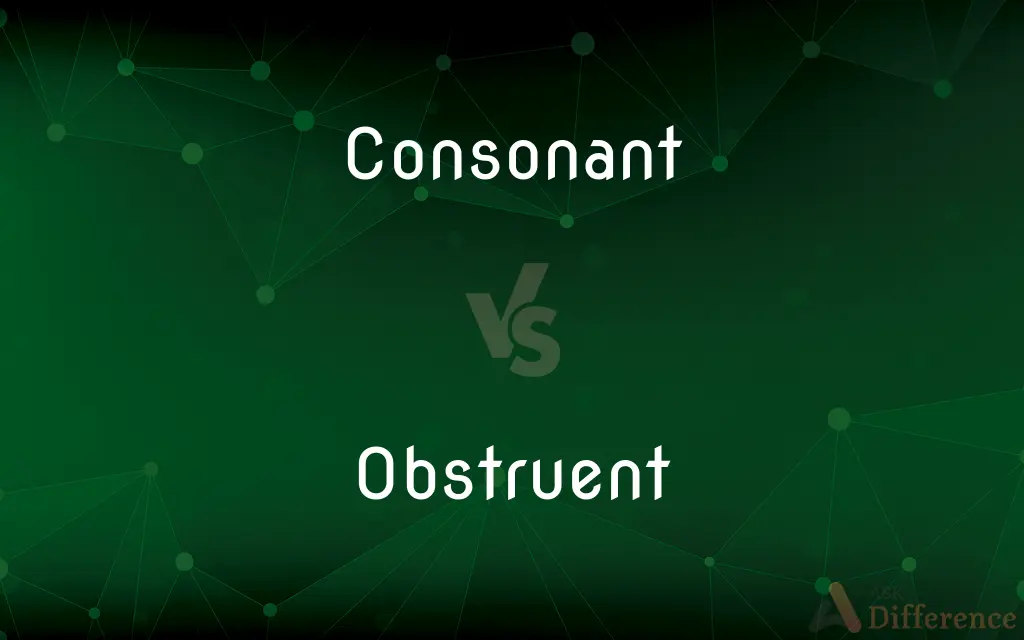Consonant vs. Obstruent — What's the Difference?
By Tayyaba Rehman & Fiza Rafique — Updated on April 5, 2024
A consonant is a class of speech sound made by obstructing the breath in the vocal tract, while an obstruent is a specific type of consonant characterized by a complete or narrow constriction between articulators, producing friction or stopping airflow.

Difference Between Consonant and Obstruent
Table of Contents
ADVERTISEMENT
Key Differences
Consonants are fundamental to the phonetics of languages, representing a broad category of sounds produced by constriction or closure at one or more points along the vocal tract. They contrast with vowels, which are sounds produced without significant closure, allowing the air to flow freely through the mouth. Obstruents, a subset of consonants, include stops (or plosives), fricatives, and affricates, distinguished by the way they obstruct airflow. Stops completely block airflow (e.g., /p/, /t/, /k/), fricatives create a narrow passage causing friction (e.g., /f/, /s/, /v/), and affricates begin as stops but release into a fricative (e.g., /ch/, /j/ in "church" and "judge").
While all obstruents are consonants, not all consonants are obstruents. Consonants also include sonorants, which, unlike obstruents, allow for more airflow and do not involve turbulent airflow. Sonorants include nasals (e.g., /m/, /n/), liquids (e.g., /l/, /r/), and glides (e.g., /w/, /j/), which are characterized by a relatively open passage for the airstream, making them closer to vowels in terms of acoustic properties.
The classification into consonants and obstruents reflects linguistic analysis and understanding of speech sounds. Consonants are classified based on various features such as voicing, place of articulation (where the constriction occurs in the vocal tract), and manner of articulation (how the sound is produced). Obstruents specifically focus on the manner of articulation, emphasizing the degree of airflow obstruction.
In terms of linguistic function, consonants, including obstruents, play critical roles in forming syllables, words, and meanings. Different languages utilize a variety of consonant sounds, and the presence, absence, or variation of certain consonant types (including obstruents) can significantly affect phonetic and phonological structures. This diversity in consonant usage contributes to the richness and complexity of human languages.
Despite their differences, both consonants and obstruents are essential for the phonetic diversity and expressiveness of languages. Understanding the distinction between them provides insight into the intricate mechanisms of speech production and the vast array of sounds humans use to communicate.
ADVERTISEMENT
Comparison Chart
Definition
A class of speech sounds made by obstructing the breath in the vocal tract.
A type of consonant made by a complete or narrow constriction that obstructs airflow.
Types
Includes obstruents and sonorants (nasals, liquids, glides).
Specifically stops (plosives), fricatives, and affricates.
Airflow Obstruction
Varies; can be complete, narrow, or more open (in sonorants).
Characterized by significant obstruction, either completely blocking or creating friction.
Relation
Broader category including various types of speech sounds.
Subset of consonants focused on a specific manner of articulation.
Examples
/p/, /t/, /k/, /m/, /n/, /l/, /r/, /w/, /j/
/p/, /t/, /k/, /f/, /s/, /v/, /ch/, /j/
Compare with Definitions
Consonant
Speech sounds produced by constriction in the vocal tract.
The sound /m/ is a consonant produced by closing the lips.
Obstruent
Includes stops, fricatives, and affricates.
/tʃ/ is an affricate obstruent, combining a stop and a fricative.
Consonant
Can be voiced or voiceless.
/v/ is voiced, while /f/ is voiceless, both being consonants.
Obstruent
Often leads to turbulent airflow.
The obstruent /f/ produces turbulence as air passes through the lip and teeth closure.
Consonant
Includes a wide variety of sounds.
Consonants include sounds like /l/, /r/, and /ʃ/.
Obstruent
Can significantly affect the phonetic quality of consonants.
Voicing in obstruents like /b/ and /p/ changes their sound.
Consonant
Integral to forming syllables and words.
The consonants /p/ and /t/ start many English words.
Obstruent
Key in distinguishing phonemes in languages.
The obstruent /k/ differentiates words like cat and bat.
Consonant
Classified by articulation and place in the vocal tract.
/k/ is a velar consonant, produced at the back of the mouth.
Obstruent
Consonants characterized by airflow obstruction.
The sound /s/ is an obstruent produced by forcing air through a narrow channel.
Consonant
In articulatory phonetics, a consonant is a speech sound that is articulated with complete or partial closure of the vocal tract. Examples are [p], pronounced with the lips; [t], pronounced with the front of the tongue; [k], pronounced with the back of the tongue; [h], pronounced in the throat; [f] and [s], pronounced by forcing air through a narrow channel (fricatives); and [m] and [n], which have air flowing through the nose (nasals).
Obstruent
An obstruent () is a speech sound such as [k], [d͡ʒ], or [f] that is formed by obstructing airflow. Obstruents contrast with sonorants, which have no such obstruction and so resonate.
Consonant
Being in agreement or accord
Remarks consonant with our own beliefs.
Obstruent
Obstructing or closing natural openings or passages of the body.
Consonant
Corresponding or alike in sound, as words or syllables.
Obstruent
An obstruent medicine or agent.
Consonant
Harmonious in sound or tone.
Obstruent
(Linguistics) A sound, such as a stop, fricative, or affricate, that is produced with complete blockage or at least partial constriction of the airflow through the nose or mouth.
Consonant
A speech sound produced by a partial or complete obstruction of the air stream by any of various constrictions of the speech organs, such as (p), (f), (r), (w), and (h).
Obstruent
Causing obstruction; blocking up.
An obstruent medicine
Consonant
A letter or character representing such a speech sound.
Obstruent
(phonetics) A consonant sound formed by obstructing the airway, causing turbulence; a plosive, fricative, or affricate.
Consonant
(phonetics) A sound that results from the passage of air through restrictions of the oral cavity; any sound that is not the dominant sound of a syllable, the dominant sound generally being a vowel.
Obstruent
(medicine) Anything that obstructs, especially in the passages of the body.
Consonant
A letter representing the sound of a consonant.
Obstruent
Causing obstruction; blocking up; hindering; as, an obstruent medicine.
Consonant
Consistent, harmonious, compatible, or in agreement
Obstruent
Anything that obstructs or closes a passage; esp., that which obstructs natural passages in the body; as, a medicine which acts as an obstruent.
Consonant
Having the same sound.
Consonant
(music) Harmonizing together; accordant.
Consonant tones; consonant chords
Consonant
Of or relating to consonants; made up of, or containing many, consonants.
Consonant
Having agreement; congruous; consistent; according; - usually followed by with or to.
Each one pretends that his opinion . . . is consonant to the words there used.
That where much is given there shall be much required is a thing consonant with natural equity.
Consonant
Having like sounds.
Consonant words and syllables.
Consonant
Harmonizing together; accordant; as, consonant tones, consonant chords.
Consonant
Of or pertaining to consonants; made up of, or containing many, consonants.
No Russian whose dissonant consonant nameAlmost shatters to fragments the trumpet of fame.
Consonant
An articulate sound which in utterance is usually combined and sounded with an open sound called a vowel; a member of the spoken alphabet other than a vowel; also, a letter or character representing such a sound.
Consonant
A speech sound that is not a vowel
Consonant
A letter of the alphabet standing for a spoken consonant
Consonant
Involving or characterized by harmony
Consonant
In keeping;
Salaries agreeable with current trends
Plans conformable with your wishes
Expressed views concordant with his background
Common Curiosities
Can obstruents be both voiced and voiceless?
Yes, obstruents can be either voiced or voiceless, affecting the sound's quality.
What is a consonant?
A consonant is a speech sound produced by partially or completely blocking the airflow in the vocal tract.
What defines an obstruent?
Obstruents are consonants characterized by significant airflow obstruction, causing either friction or a complete stop of airflow.
What are some examples of consonants?
Examples include /m/, /n/, /s/, and /l/, representing different types of consonants.
How do obstruents affect language?
Obstruents significantly affect a language's phonetic and phonological systems due to their acoustic properties.
How do consonants differ from vowels?
Consonants involve airflow obstruction, whereas vowels are produced with an open vocal tract.
Are all consonants obstruents?
No, not all consonants are obstruents; obstruents are a subset of consonants defined by their airflow obstruction.
How does airflow obstruction define obstruents?
Obstruents are defined by the degree of airflow obstruction, which results in friction or complete stoppage.
What are some examples of obstruents?
Examples include /p/, /b/, /t/, /d/, and /f/, which are types of obstruents.
How are consonants classified?
Consonants are classified based on their place of articulation, manner of articulation, and voicing.
What role do consonants play in speech?
Consonants play a crucial role in forming syllables, words, and contributing to speech clarity and intelligibility.
What is the significance of voicing in consonants?
Voicing distinguishes sounds in both consonants and obstruents, impacting their phonetic and phonological properties.
Share Your Discovery

Previous Comparison
Hacienda vs. Rancho
Next Comparison
Hatch vs. HutchAuthor Spotlight
Written by
Tayyaba RehmanTayyaba Rehman is a distinguished writer, currently serving as a primary contributor to askdifference.com. As a researcher in semantics and etymology, Tayyaba's passion for the complexity of languages and their distinctions has found a perfect home on the platform. Tayyaba delves into the intricacies of language, distinguishing between commonly confused words and phrases, thereby providing clarity for readers worldwide.
Co-written by
Fiza RafiqueFiza Rafique is a skilled content writer at AskDifference.com, where she meticulously refines and enhances written pieces. Drawing from her vast editorial expertise, Fiza ensures clarity, accuracy, and precision in every article. Passionate about language, she continually seeks to elevate the quality of content for readers worldwide.
















































